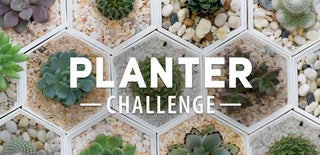Introduction: Rustic Cork Planter
This here is a super quick and easy build. I made it in the space of 2 hours, and that's including repositioning the camera and taking photos. What is it, you might ask?
This is a rustic looking planter that utilizes old wine corks for an outer shell, which lends it a very naturalistic and, well, rustic appesarance, hence the name.
But why did I, a guy obsessed by LEDs, Arduino, and everything electronic, decide to build this? Truth to be told, I have a bit of a hidden passion for plants, and so does my mother. Recently my mom decided to get some new indoor plants, plants for which she needed planters. Seeing how there was a planter challenge going on, I decided to make a couple entries.
Please don't forget to vote if you like this, and let's get building!
Step 1: Materials
Always have what you need, and you will never need anything. Funny how that works, isn't it?
Materials:
Lots and lots of assorted wine and champagne corks
Twine (the brown stuff)
A large plastic pot
A saucer 1 size larger than the pot
Landscaping rocks and pebbles
Tools:
Hot glue gun
Utility Knife
Scissors
Step 2: Cutting the Corks
The first step is to carefully cut all the corks in half legnthwise using the utility knife. I cut myself a few times (nothing major, don't worry) before I realized I either needed to wear utility gloves or clamp down the corks. Please learn from my mistake and do one or both of these things to avoid injury.
Step 3: Randomization
To give your planter a more rustic look, it is better to have the corks in a random order.
To achieve this, put all of the cut corks in your pot and shake them up to randomize them. Then, dump them out.
Step 4: The First Layer
Using the hot glue gun, glue down your first layer of corks right below the rim of the pot. Cut every other cork in half to further increase the rustic look.
Step 5: The Middle Layers
Use the hot glue gun to glue down corks in rows until there is about one cork's length from the bottom of the pot to the lowermost layer. On the bottom layer, again cut every other cork in half so the bottom is (mostly) even.
Note: Due to the taper of the pot, you may have to shave down the edges of some corks to make them fit.
Step 6: The Upper Rim
On the upper rim of the pot, hot glue a ring of corks to hide the "lip". I made an alternating pattern of normal and champagne corks because I thought it would look better that way.
Step 7: The Lower Rim
Around the base of the pot, glue another ring of corks right up against the bottom row. There should still be some pot left showing.
The purpose of leaving the little bit of plastic at the bottom of the pot is to prevent the corks from wicking up water and rotting.
Step 8: Saucer and Pebbles
Now, fill your saucer with a layer of rocks/pebbles. Place the pot on top of this layer, and add a ring of rocks around the base of the pot to hide any of the plastic that is showing.
Step 9: Twine
To spiff up our rather boring saucer, hot glue a few rings of twine around the lip.
Step 10: The Grand Finale
Now we have an amazing looking planter!
My mother was quite pleased with the result, and I must say I quite like it too. The choice of plant also helps highlight the planter, and my mom did an exellent job of getting an amazing, leafy green oxygen machine all happy in its new home!
I hope you like this planter as much as we do, and if you have any suggestions I'd love to hear them in the comments. If you haven't already, there is a "Vote" button floating around here somewhere, and I think you are supposed to click on it (why else is it there?).
As always, these are the projects of Dangerously Explosive, his lifelong mission, "to boldly build what you want to build, and more!"
You can find the rest of my projects here.
Happy Making (and planting)!

Participated in the
Planter Challenge













